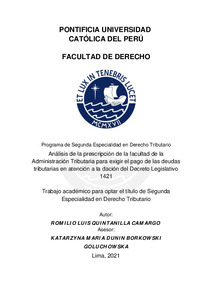| dc.contributor.advisor | Dunin-Borkowski Goluchowska, Katarzyna María | |
| dc.contributor.author | Quintanilla Camargo, Romilio Luis | |
| dc.date.accessioned | 2022-03-24T21:05:00Z | |
| dc.date.available | 2022-03-24T21:05:00Z | |
| dc.date.created | 2021 | |
| dc.date.issued | 2022-03-24 | |
| dc.identifier.uri | http://hdl.handle.net/20.500.12404/21933 | |
| dc.description.abstract | En el presente artículo se analiza el tratamiento de la facultad de la administración
tributaria para el cobro de las deudas tributarias (potestad de exigir el pago) a través de
las diversas modificaciones del Código Tributario que se dieron a dicha potestad. A través
de dicho análisis se evidencia el origen del problema en donde se podrían generar
escenarios en los cuales la administración tributaria podría determinar una deuda, pero no
cobrarla, lo cual llevó a la emisión de una resolución de observancia obligatoria por parte
del Tribunal Fiscal y la posterior emisión del Decreto Legislativo Nro. 1421, norma que
fue bastante mediática y cuestionada por parte de los contribuyentes, lo que llevó a una
demanda de inconstitucionalidad que fue resuelta 2 años después de la emisión de la
norma. Del análisis de las normas emitidas, se determina el origen del problema del plazo
de prescripción de la facultad de la administración tributaria para exigir el pago de deudas
tributarias, iniciándose este con la emisión del Decreto Legislativo Nro. 981, empeorando
con la emisión del Decreto Legislativo Nro. 1113 y siendo finalmente “corregido” a través
del Decreto Legislativo Nro. 1421, norma que finalmente fue validada por una sentencia
del Tribunal Constitucional. | es_ES |
| dc.description.abstract | This article analyzes the treatment of the faculty of the tax administration to enforce the
collection of tax debts (authority to demand payment) through the several modifications
of the Tax Code that were made to such faculty. This analysis shows the origin of the
problem, resulting in scenarios in which the tax administration could determine a debt,
but not be able to collect it, which led to the issuance of a binding resolution by the Tax
Court and the subsequent issuance of Legislative Decree No. 1421, a rule that was highly
controversial and questioned by taxpayers, which led to a claim of unconstitutionality that
was settled 2 years after the issuance of the rule. From the analysis of the regulations
issued, the origin of the problem of the statute of limitations of the power of the tax
administration to enforce payment of tax debts is determined, starting with the issuance
of Legislative Decree No. 981, getting worse with the issuance of Legislative Decree No.
1113 and finally being "corrected" through Legislative Decree No. 1421, a regulation that
was finally validated by a decision of the Constitutional Court. | es_ES |
| dc.language.iso | spa | es_ES |
| dc.publisher | Pontificia Universidad Católica del Perú | es_ES |
| dc.rights | info:eu-repo/semantics/openAccess | es_ES |
| dc.rights.uri | http://creativecommons.org/licenses/by-nc-nd/2.5/pe/ | * |
| dc.subject | Derecho tributario--Legislación--Perú | es_ES |
| dc.subject | Administración tributaria--Perú | es_ES |
| dc.subject | Deuda | es_ES |
| dc.title | Análisis de la prescripción de la facultad de la Administración Tributaria para exigir el pago de las deudas tributarias en atención a la dación del Decreto Legislativo 1421 | es_ES |
| dc.type | info:eu-repo/semantics/bachelorThesis | es_ES |
| thesis.degree.name | Segunda Especialidad en Derecho Tributario | es_ES |
| thesis.degree.level | Título Profesional | es_ES |
| thesis.degree.grantor | Pontificia Universidad Católica del Perú. Facultad de Derecho | es_ES |
| thesis.degree.discipline | Derecho Tributario | es_ES |
| renati.advisor.dni | 07884910 | |
| renati.advisor.orcid | https://orcid.org/0000-0002-2016-7292 | es_ES |
| renati.author.dni | 70100639 | |
| renati.discipline | 421169 | es_ES |
| renati.level | https://purl.org/pe-repo/renati/level#tituloSegundaEspecialidad | es_ES |
| renati.type | https://purl.org/pe-repo/renati/type#trabajoAcademico | es_ES |
| dc.publisher.country | PE | es_ES |
| dc.subject.ocde | https://purl.org/pe-repo/ocde/ford#5.05.01 | es_ES |






